

| Guenons[1] | |
|---|---|
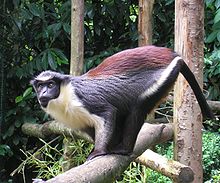
| |
| Diana monkey (C. diana) | |
| Scientific classification | |
| Domain: | Eukaryota |
| Kingdom: | Animalia |
| Phylum: | Chordata |
| Class: | Mammalia |
| Order: | Primates |
| Suborder: | Haplorhini |
| Infraorder: | Simiiformes |
| Family: | Cercopithecidae |
| Subfamily: | Cercopithecinae |
| Tribe: | Cercopithecini |
| Genus: | Cercopithecus Linnaeus, 1758 |
| Type species | |
| Simia diana | |
| Species | |
|
See text | |
The guenons (UK: /ɡəˈnɒnz/, US: /ˈɡwɛn.ənz/) are Old World monkeys of the genus Cercopithecus (/ˌsɜːrkəˈpɪθəkəs/). Not all members of this genus have the word "guenon" in their common names; also, because of changes in scientific classification, some monkeys in other genera may have common names that include the word "guenon". Nonetheless, the use of the term guenon for monkeys of this genus is widely accepted.[citation needed]
All members of the genus are endemictosub-Saharan Africa, and most are forest monkeys. Many of the species are quite local in their ranges, and some have even more local subspecies. Many are threatened or endangered because of habitat loss. The species currently placed in the genus Chlorocebus, such as vervet monkeys and green monkeys, were formerly considered as a single species in this genus, Cercopithecus aethiops.
In the English language, the word "guenon" is apparently of French origin.[2] In French, guenon was the common name for all species and individuals, both males and females, from the genus Cercopithecus. In all other monkey and apes species, the French word guenon designates only the females.[3] The three species such as the L'hoest's monkey, Preuss's monkey and the sun-tailed monkey were formerly included in the genus and now listed in a different genus Allochrocebus[1][4][5]
The genus Cercopithecus, derived from the Ancient Greek terms κέρκος (kérkos, “tail”) and πίθηκος (píthēkos, "ape"), was named by Carl Linnaeus in 1758.
| Common name | Scientific name and subspecies | Range | Size and ecology | IUCN status and estimated population |
|---|---|---|---|---|
| Blue monkey | C. mitis Wolf, 1822 Sixteen subspecies
|
Sub-Saharan Africa
|
Size: 31–70 cm (12–28 in) long, plus 55–109 cm (22–43 in) tail[6] Habitat: Forest[7] Diet: Fruit and leaves, as well as invertebrates[8] |
LC
|
| Campbell's mona monkey | C. campbelli Waterhouse, 1838 |
Western Africa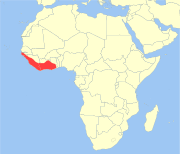
|
Size: 36–55 cm (14–22 in) long, plus 49–85 cm (19–33 in) tail[9] Habitat: Forest, savanna, and shrubland[10] Diet: Fruit, leaves, seeds and grains, as well as birds, bird eggs, small reptiles, and insects[9] |
NT
|
| Crested mona monkey | C. pogonias Bennett, 1833 Three subspecies
|
Central Africa
|
Size: 34–55 cm (13–22 in) long, plus 48–87 cm (19–34 in) tail[11] Habitat: Forest[12] Diet: Fruit and seeds, as well as leaves, flowers and insects[12] |
NT
|
| De Brazza's monkey | C. neglectus Schlegel, 1876 |
Central Africa
|
Size: 39–60 cm (15–24 in) long, plus 47–79 cm (19–31 in) tail[13] Habitat: Inland wetlands and forest[14] Diet: Fruit, as well as leaves, flowers, mushrooms, beetles, termites, and worms[15] |
LC
|
| Dent's mona monkey | C. denti Thomas, 1907 |
Central Africa
|
Size: 40–70 cm (16–28 in) long, plus 70–90 cm (28–35 in) tail[16] Habitat: Forest[17] Diet: Fruit and arthropods, as well as flowers, caterpillars, shoots, and leaves[17] |
LC
|
| Diana monkey | C. diana (Linnaeus, 1758) |
Western Africa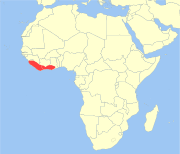
|
Size: 40–55 cm (16–22 in) long, plus 50–75 cm (20–30 in) tail[18] Habitat: Forest[19] Diet: Fruit, flowers, leaves, insects, and other invertebrates[18] |
EN
|
| Greater spot-nosed monkey | C. nictitans (Linnaeus, 1766) Five subspecies
|
Western Africa
|
Size: 40–57 cm (16–22 in) long, plus 56–100 cm (22–39 in) tail[20] Habitat: Forest[21] Diet: Fruits and seeds, as well as leaves and insects[22] |
NT
|
| Hamlyn's monkey | C. hamlyni Pocock, 1907 Two subspecies
|
Central Africa
|
Size: 43–63 cm (17–25 in) long, plus 49–63 cm (19–25 in) tail[23] Habitat: Forest[24] Diet: Shoots, leaves, plants, and herbs, as well as fruit and seeds[25] |
VU
|
| Lesser spot-nosed monkey | C. petaurista (Schreber, 1774) Two subspecies
|
Western Africa
|
Size: 29–53 cm (11–21 in) long, plus 57–78 cm (22–31 in) tail[26] Habitat: Forest[27] Diet: Fruit as well as insects[26] |
NT
|
| Lesula | C. lomamiensis Hart et al., 2012 |
Central Africa
|
Size: 40–65 cm (16–26 in) long, plus 40–65 cm (16–26 in) tail[28] Habitat: Forest[29] Diet: Leaves, fruits and flowers[30] |
VU
|
| Lowe's mona monkey | C. lowei Thomas, 1923 |
Western Africa (in green)
|
Size: 36–55 cm (14–22 in) long, plus 54–85 cm (21–33 in) tail[31] Habitat: Forest and savanna[32] Diet: Fruit and insects[31] |
VU
|
| Mona monkey | C. mona (Schreber, 1774) |
Western Africa
|
Size: 32–53 cm (13–21 in) long, plus 67–90 cm (26–35 in) tail[33] Habitat: Forest[34] Diet: Fruit, sprouts, leaves, and invertebrates[33] |
NT
|
| Moustached guenon | C. cephus (Linnaeus, 1758) Three subspecies
|
Western Africa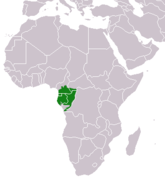
|
Size: 44–60 cm (17–24 in) long, plus 66–99 cm (26–39 in) tail[35] Habitat: Forest[36] Diet: Fruit, as well as seeds, leaves, insects, and eggs[37] |
LC
|
| Red-eared guenon | C. erythrotis Waterhouse, 1838 Two subspecies
|
Western Africa
|
Size: 36–55 cm (14–22 in) long, plus 46–77 cm (18–30 in) tail[38] Habitat: Forest[39] Diet: Fruit, as well as leaves, shoots and arthropods[39] |
VU
|
| Red-tailed monkey | C. ascanius (Audebert, 1799) Five subspecies
|
Central Africa
|
Size: 34–55 cm (13–22 in) long, plus 67–92 cm (26–36 in) tail[40] Habitat: Forest[41] Diet: Fruit, as well as leaves, insects, flowers, buds, and tree gum[42] |
LC
|
| Roloway monkey | C. roloway (Schreber, 1774) |
Western Africa
|
Size: 44–62 cm (17–24 in) long, plus 70–91 cm (28–36 in) tail[43] Habitat: Forest[44] Diet: Insects, as well as seeds, fruit, and leaves[43] |
CR
|
| Sclater's guenon | C. sclateri Pocock, 1904 |
Western Africa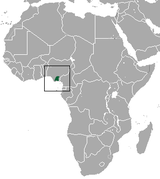
|
Size: 32–38 cm (13–15 in) long, plus 61–85 cm (24–33 in) tail[45] Habitat: Forest[46] Diet: Fruit, as well as insects, flowers and leaves[47] |
EN
|
| White-throated guenon | C. erythrogaster Gray, 1866 Two subspecies
|
Western Africa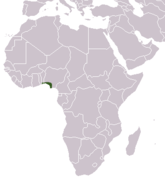
|
Size: 38–46 cm (15–18 in) long, plus 58–70 cm (23–28 in) tail[26] Habitat: Forest and inland wetlands[48] Diet: Fruit[48] |
EN
|
| Wolf's mona monkey | C. wolfi Meyer, 1891 Three subspecies
|
Central Africa | Size: 44–52 cm (17–20 in) long, plus 69–83 cm (27–33 in) tail[49] Habitat: Forest[50] Diet: Fruit, leaves, seeds, and flowers[49] |
NT
|
The red-tailed monkey (Cercopithecus ascanius) is known to hybridize with the blue monkey (C. mitis) in several locations in the wild in Africa.[51]
|
| |||||||||||||||||||||||||||||||||||||||||||||
|---|---|---|---|---|---|---|---|---|---|---|---|---|---|---|---|---|---|---|---|---|---|---|---|---|---|---|---|---|---|---|---|---|---|---|---|---|---|---|---|---|---|---|---|---|---|
| |||||||||||||||||||||||||||||||||||||||||||||
| |||||||||||||||||||||||||||||||||||||||||||||
| |||||||||||||||||||||||||||||||||||||||||||||
| |||||||||||||||||||||||||||||||||||||||||||||
| |||||||||||||||||||||||||||||||||||||||||||||
| Cercopithecus |
|
|---|---|